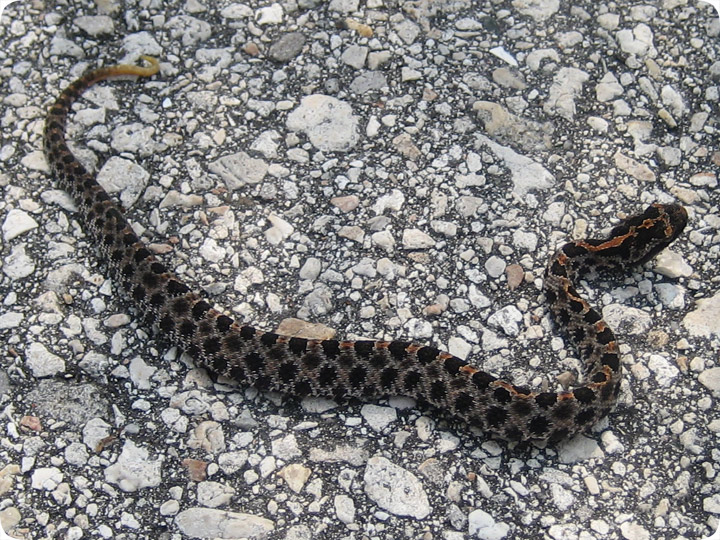-
info@aaanimalcontrol.com
Call us for help in your town
Humane Wildlife Education
Pygmy Rattlesnake

08.08.2007 - Ah, the Pygmy Rattlesnake - one of central Florida's four species of venomous snake. It's supposedly the most common of the four, but I never find them.
I see more Cottonmouths, and I've even caught a few Eastern Diamondbacks and Coral Snakes. This snake is actually the Dusky Pygmy Rattlesnake, Sistrurus miliarius
barbouri.
There's a few different species of Pygmies, and they live in the SE United States. I cannot determine if the proper spelling is Pigmy Rattlesnake or Pygmy, but both spellings are used
for the snake. Some people misspell this snake as Pygmie Rattlesnake. It's often called a "Ground Rattler", or "Little Bastard Rattler".
This snake, as its name implies, is very small. It rarely grows above 18 inches. It's got a teensy tiny little rattle on the tip
of its tail, and most people wouldn't even be able to hear it. The younger snakes, such as the one seen above, have yellow-tipped tails. Some people liken the rattle to the faint buzz of an insect. This snake apparently has a nasty disposition, and won't
hesitate to strike.
Though the snake is too small to produce enough venom to kill a person, the bite is extremely painful. A young man once called me to ask for a job (I get about 50
such calls per year, even though I have no job to offer), and we talked snakes for a little while. He said that he was once collecting Pygmy Rattlers, when one bit him in the finger. "What did you do?"
I asked him. "I went home and got drunk", he replied, "and then four hours later I was in the hospital, bawling like a little baby". He said that the pain was unbelievable, the worst
pain of his life, and that he lost the finger due to dissolved tissue. So this snake, like all venomous snakes, should not be treated carelessly! It's more likely to strike than the
larger rattlesnakes.
Do it yourself: Visit my How To Get Rid of Snakes page for tips and advice.
Get professional help: Visit my Nationwide Pro Directory of wildlife removal experts.
For more wildlife stories, click my Wildlife Blog
or click my below banner to hire a local trapper.
You can also catch snakes with a special trap, which you can order by clicking this banner:

The Pygmy Rattlesnake is a snake most commonly found in the state of Florida. While you may have seen them many times, you may not know a lot about them. Here's everything you need to know about the Pygmy Rattlesnake.
Naming
While you know this snake as the Pygmy Rattlesnake, there are actually lots of other names for this species of snake. Its scientific classification is the Sistrurus miliarius. You'll also see the snake referred to as the:
- Hog-nosed rattlesnake
- Spotted rattler
- Ground rattlesnake
- Oak leaf rattler
- Little rattlesnake
Appearance
This snake usually grows to around 40 – 60 cm in length as an adult. There are some reports of these snakes growing longer, but these are often ones that are kept in captivity, which isn't common.
Their patterning has a series of oval or sub-circular spots, with irregular edges. These spots are dark, especially along the back. They'll also be separated by a reddish-brown stripe down the spine. The tip of their tail has a tiny rattle, which is prone to breaking off.
Habitat
The Pygmy Rattlesnake is usually found in Florida in a wide variety of habitats. It can live in dry forests, sand hills, flooded flatlands, and marshes. It also has a habit of taking up home in urban areas. Homeowners are most likely to find them under brush piles or in their gardens.
Behavior
If you see a Pygmy Rattlesnake, you're most likely going to see it sunning itself on roads late in the day. They will use their rattle, but because it's so small you may not hear it unless you're a few feet away. This rattle makes a buzzing noise as it's shaken. The snake isn't known for creating its own burrows. Instead, they will use burrows that have been dug by small rodents.
Venom
The Pygmy Rattlesnake is a venomous snake, although it isn't able to produce enough venom to harm a human. While the bite won't kill an adult, it will be unpleasant and cause serious discomfort. They pose more of a danger to children, with many being hospitalized after being bitten. In some cases, the bite even leads to necrosis.
An interesting fact about this venom is that it was the basis of the drug Eptifibatide, which helps prevent clotting during a heart attack.
Diet
The Pygmy Rattlesnake will eat small mammals, lizards, insects, frogs, other snakes, and even giant desert centipedes. They hunt the prey by grabbing it and injecting venom in order to prevent injury by their prey before they eat. They also use their rattles as lures when looking to attract lizards near them.
Pygmy Rattlesnakes are an interesting species of snake that you should watch out for if you live in Florida, especially if you have children. They're small and their venom can't kill an adult, but it can cause problems for you. for you.




















